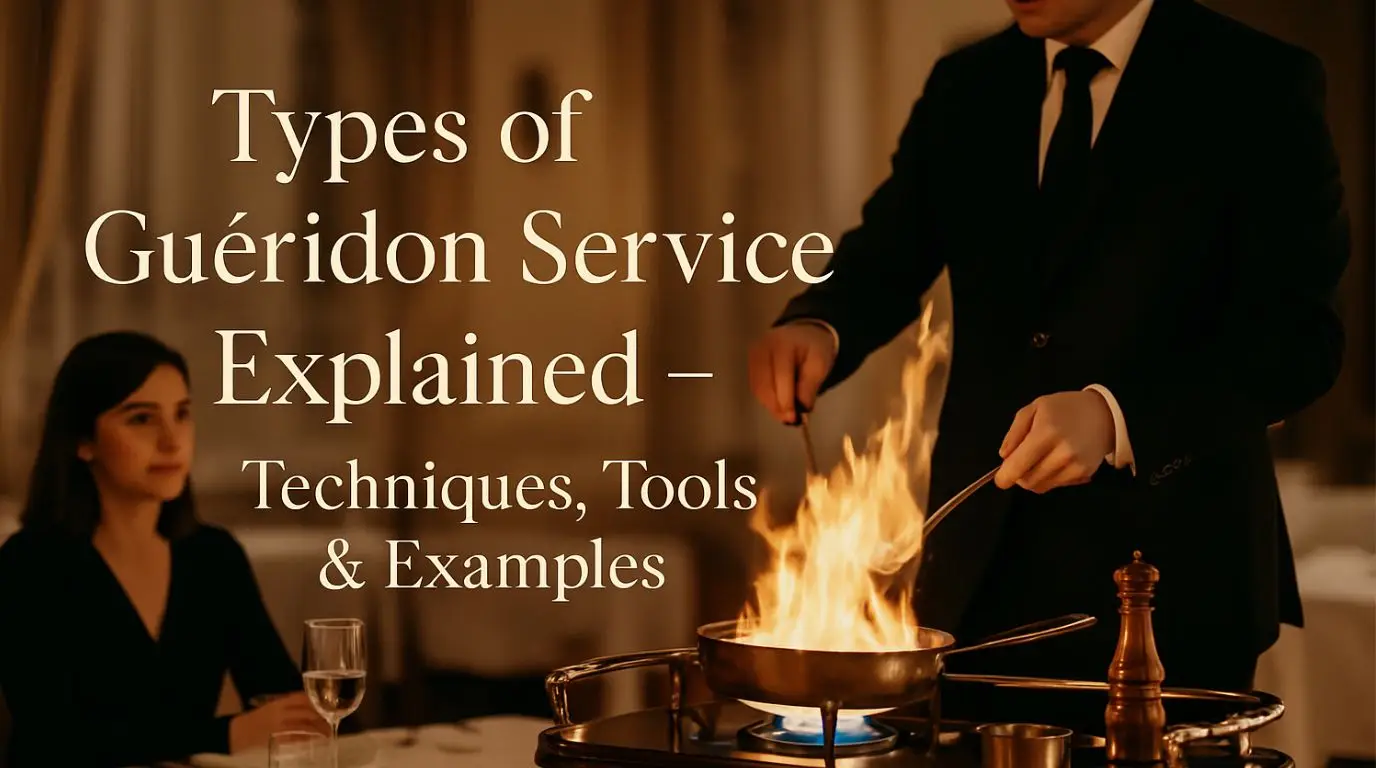Gueridon service is one of the most elegant and personalised styles of table service in fine dining. It turns an ordinary meal into a live culinary experience, with food prepared or finished right beside the guest using a special trolley, known as a gueridon.
But Gueridon service isn’t just one method — it includes a variety of techniques, each requiring specific skills, tools, and presentation styles. From the dramatic flair of flambé dishes to the careful art of filleting fish at the table, each type brings something unique to the dining experience.
In this guide, we go beyond the basics to explore the main types of Gueridon service. You’ll learn about:
- The equipment used for each service style
- Step-by-step techniques
- The skills required by service staff
- Operational pros and cons of each type
This article is a valuable resource for hospitality students, educators, and food & beverage professionals aiming to understand and master the refined art of Gueridon service.
1. Flambé Service
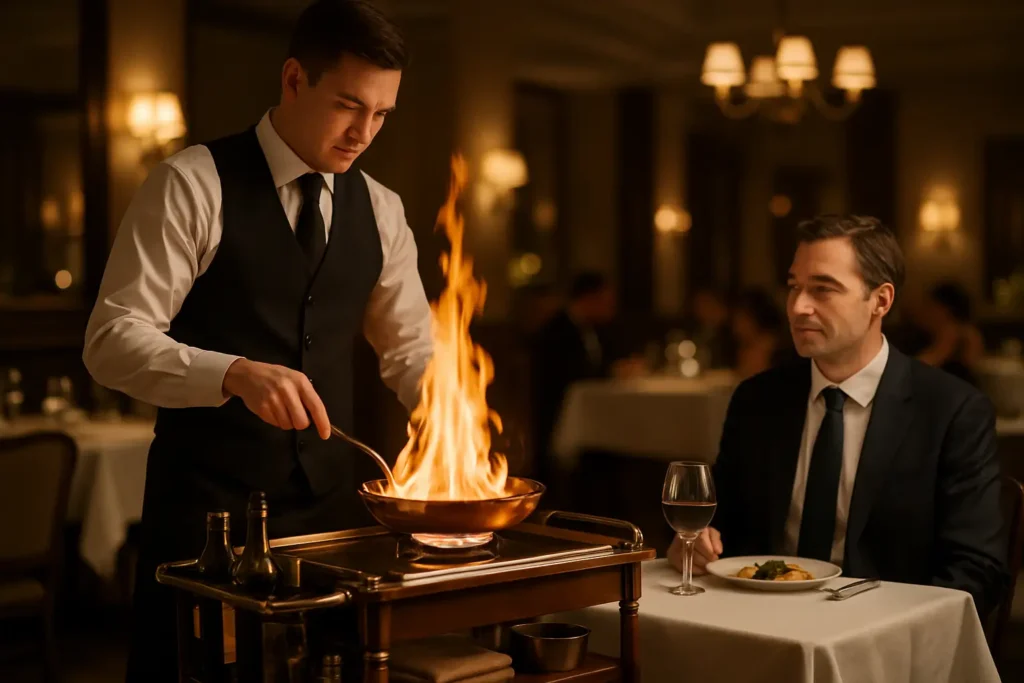
Flambé service is one of the most spectacular forms of Gueridon service. It involves cooking or finishing a dish at the guest’s table by igniting alcohol in a hot pan. The burst of flame creates a dramatic visual effect, filling the air with aroma and elevating the overall dining experience.
This method is commonly used in fine-dining restaurants, luxury hotels, and traditional steakhouses to impress guests and enhance the value of the meal.
Flambé isn’t just about fire—it’s about combining culinary technique with guest entertainment.
Benefits of Flambé:
- Guest Engagement: The flames attract attention and create excitement.
- Menu Appeal: Dishes served flambé-style often become signature items.
- Flavour Enhancement: Burning off alcohol leaves behind concentrated flavours.
How It Works:
- A high-proof spirit (usually around 40% ABV) is added to a hot pan.
- The alcohol vaporises and ignites, creating a controlled flame.
- Most of the alcohol is burned or evaporated, removing harshness while enhancing aroma.
The Flambé Trolley:
A flambé service requires a special trolley equipped for safety and performance.
Key Features of a Flambé Trolley:
- Heat Source: Typically, a spirit lamp or gas burner.
- Work Surface: Heat-resistant top (often stainless steel).
- Storage Space: Shelves and compartments for ingredients and utensils.
- Special Cookware:
- Suzette pan: Shallow, silver-plated copper pan for even heat distribution.
- Not to be confused with chafing dishes (used for keeping food warm).
Classic Flambé Dishes
Flambé service is often used with classic, high-impact dishes. Here are some well-known examples:
| Dish | Description |
|---|---|
| Crêpes Suzette | Crêpes served in orange-butter sauce, flambéed with Grand Marnier and Cognac. |
| Steak Diane | Tender steak cooked tableside, finished with a flambéed brandy cream sauce. |
| Bananas Foster | Bananas flambéed with brown sugar, cinnamon, and rum, served over vanilla ice cream. Originated in New Orleans. |
| Cherries Jubilee | Cherries poached in syrup, flambéed with cherry brandy, and served over ice cream. |
Learn more about the history and technique of flambé cooking on Wikipedia. This classic method combines fire, flavour, and flair in fine-dining tradition.
2. The Carver’s Art: Jointing and Slicing
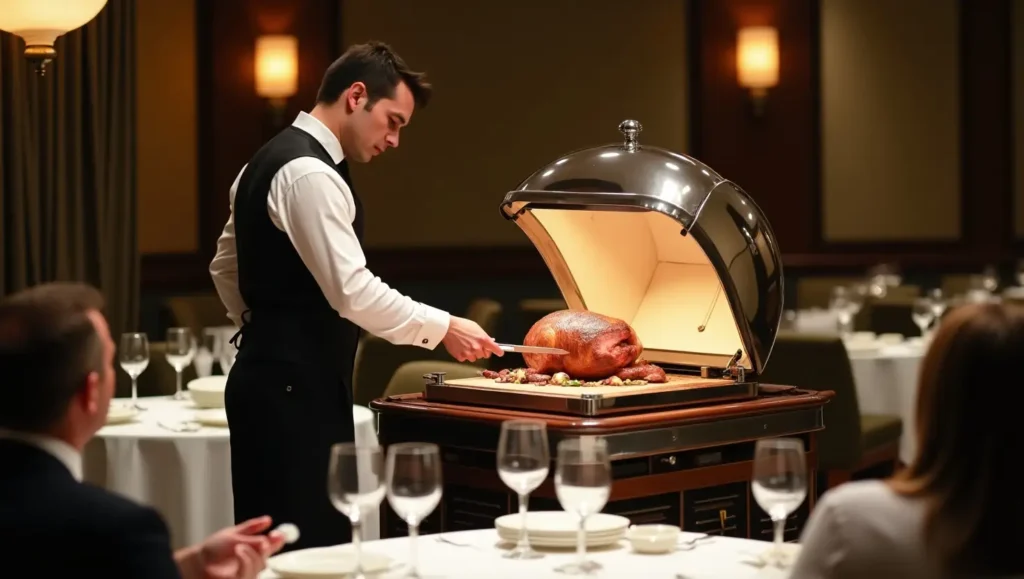
Tableside carving is one of the most traditional and visually impressive forms of Gueridon service. A large roast or whole bird is wheeled into the dining room and expertly sliced in front of the guests. This service highlights the quality of the product, the skill of the carver, and adds an old-world charm to the dining experience.
Rooted in European fine dining and the traditions of royal banquets, carving service is still used today in high-end restaurants, steakhouses, and banquets where elegance and showmanship are part of the guest experience.
The Carving Trolley
The carving or roast beef trolley is a specialised piece of equipment designed for both function and visual appeal. It often features polished stainless steel, silver, or rich wood finishes to reflect the premium nature of the service.
Key Features of a Carving Trolley:
- Heated Surface: Keeps meat at serving temperature, usually using a bain-marie or spirit burners. Some modern trolleys are electric.
- Carving Board with Drip Tray: Collects juices that can be used as sauce or jus.
- Domed Lid: A dramatic reveal when opened at the table; retains heat and enhances presentation.
- Storage Compartments: Holds carving knives, forks, ladles, sauces, and heated plates.
Signature Dishes for Tableside Carving
Carving service is ideal for large, premium cuts of meat and whole roasted birds. Here are some classics:
| Dish | Service Style |
|---|---|
| Prime Rib of Beef | Presented and sliced to guest preference (e.g., thick, thin, end cut). Famous at Lawry’s and House of Prime Rib. |
| Whole Roasted Poultry | Chicken, duck, or turkey is carved into portions tableside. |
| Peking Duck | Crispy skin and meat separated by a skilled carver, often served with pancakes and sauces. |
| Rack of Lamb | Carved into individual chops from a frenched rack. |
| Chateaubriand | Centre-cut tenderloin, sliced and plated for two guests. |
| Signature Pork Chops | At Perry’s Steakhouse, a thick seven-foot-high pork chop is carved at the table. |
Skills Required for Effective Carving Service
This type of Gueridon service demands precision, speed, and confidence. Guests watch every motion, so presentation and technique are critical.
Knife Skills:
- Use smooth, steady strokes—never saw the meat.
- Always slice against the grain for tenderness.
- Keep slices even and neat.
Knowledge of Anatomy:
- Understand how bones and muscles are structured.
- Cut at natural joints to avoid splintering.
- Know prized portions (e.g., “oysters” on a chicken’s back).
Poise and Timing:
- Perform the service with calm confidence.
- Carve efficiently (e.g., carve a roast chicken in under 3 minutes) to keep side dishes hot.
3. Tableside Salad Preparation
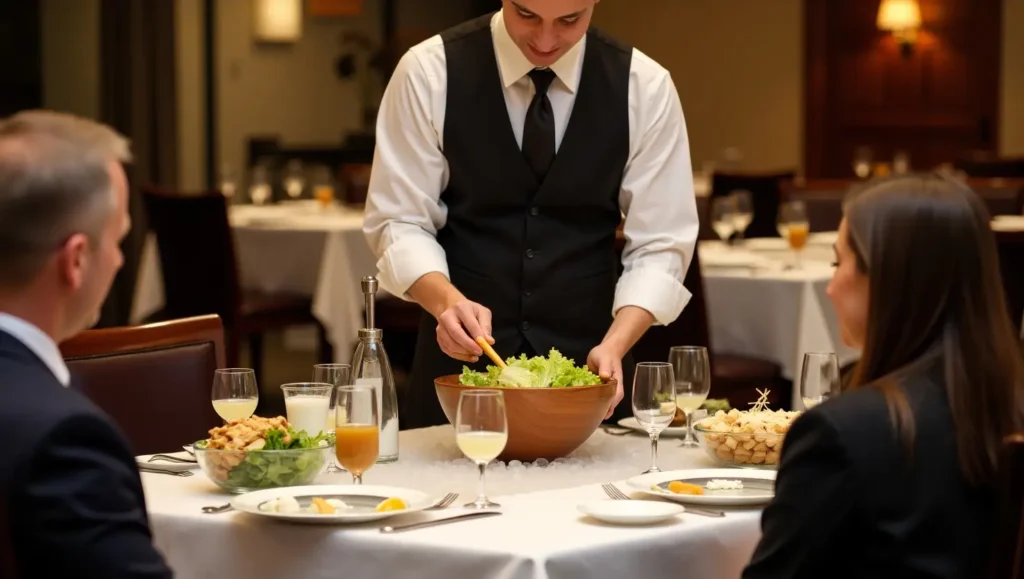
Tableside salad preparation brings simplicity and freshness to life, right in front of the guest. More than just tossing greens, this style of Gueridon service transforms the salad course into a personalised, interactive experience. The server becomes a culinary guide, engaging with the diner to create a dish tailored to their preferences.
This service is especially popular in fine-dining restaurants and steakhouses, where elegance, customisation, and visual appeal are part of the brand.
The Salad Trolley
The salad trolley is a mobile, chilled workstation that holds and displays all ingredients needed for preparing the salad on the spot.
Key Features of a Salad Trolley:
- Chilled Surface: Often includes a cold well or an ice bed to keep greens and perishables fresh.
- Ingredient Containers: Small compartments for prepped items like lettuce, vegetables, cheeses, and garnishes.
- Mixing Bowl: Traditionally, wooden, especially for Caesar salad, as it absorbs flavours over time.
- Tools & Dressings: Equipped with spoons, forks, whisks, and carafes for oils, vinegars, and seasonings.
The Tableside Caesar Salad: A Step-by-Step Breakdown
The tableside Caesar salad is the gold standard of this Gueridon style. It combines flavour building with a bit of culinary theatre, engaging the guest through each step.
Step 1: Build the Base
- Add garlic, anchovies, and salt to the wooden bowl.
- Mash into a paste using a fork to release the deep, savoury flavours.
Step 2: Create the Emulsion
- Add egg yolk, Dijon mustard, lemon juice, and Worcestershire sauce.
- Slowly whisk in olive oil to form a creamy, stable dressing.
Step 3: Toss the Salad
- Add whole romaine leaves, Parmesan cheese, and croutons.
- Toss gently with spoons, coating every leaf without bruising.
Step 4: Plate and Garnish
- Serve the salad on chilled plates.
- Finish with fresh black pepper, lemon, or a final sprinkle of cheese.
Required Skills
To perform tableside salad preparation well, the server must be skilled in both food handling and interpersonal communication.
Culinary Skills: Chefs should understand techniques like emulsification and the role of each ingredient in a dish. They must also be able to adjust seasoning and components based on guest preferences.
Guest Interaction: Engaging with guests is key—asking questions such as “Would you like extra garlic?” or “Are anchovies okay?” helps tailor the experience. Flexibility is essential to accommodate dietary needs and personal tastes.
Grace Under Pressure: A clean, confident approach is vital. Even during peak service, chefs should deliver a smooth, mess-free performance while handling tools with precision.
See a real-world example of Dover Sole filleted tableside at Faber Restaurants. It illustrates the elegance and precision of classic guéridon-style fish service.
4. Tableside Fish Filleting
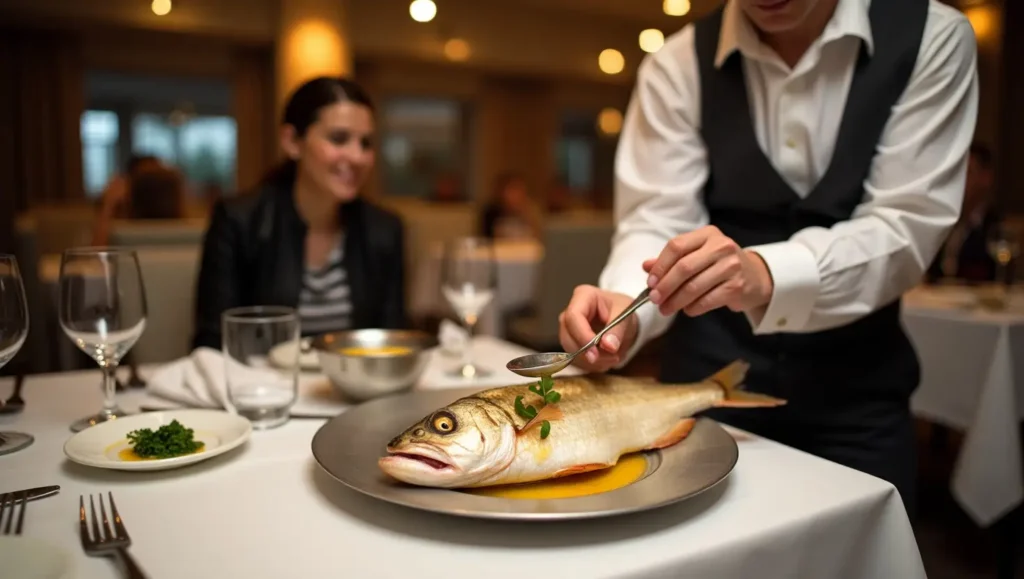
Tableside fish filleting is one of the most refined forms of Gueridon service. It combines culinary precision with showmanship, turning the simple act of serving fish into a live demonstration of expertise and freshness. Presenting and deboning a whole cooked fish in front of the guests builds trust and highlights the restaurant’s commitment to quality, justifying a premium dining experience.
Unlike flambé or carving trolleys, this service relies on a few specialised tools, all used with finesse. The fish is brought out from the kitchen on a platter and prepared at a side table or gueridon.
Essential Equipment:
- Fillet Knife: A flexible, thin blade used for initial cuts and separating skin from flesh without tearing the meat.
- Service Spoon & Fork: Often, a skilled server can fillet a fish using just these, especially with delicate species like Dover sole.
- Fish Tweezers: For removing any remaining pin bones after the skeleton is removed.
- Kitchen Shears: Used to trim fins and tail before filleting begins for a cleaner presentation.
The Gold Standard: Dover Sole Meunière
Dover Sole Meunière, pan-fried in butter and served whole, is considered the classic benchmark for this type of tableside service. The process is elegant and precise, requiring confident technique and a gentle hand.
Step-by-Step Filleting Process:
- Presentation: The whole, golden-brown sole is presented on a platter for the guest to admire.
- Trimming the Fins: Using a spoon and fork, the server makes precise incisions to remove the small fins from the edges.
- Scoring the Backbone: A shallow cut is made down the centerline of the fish to expose the backbone.
- Lifting the Top Fillets: With the edge of the spoon, the top fillets are gently separated from the bone and set aside.
- Removing the Skeleton: The head is lifted, and the entire central bone structure is removed in one smooth motion, revealing two bottom fillets.
- Plating the Fish
- The four fillets are inspected for stray bones, then carefully plated—often arranged to resemble the original fish.
- Warm brown butter (beurre noisette), lemon, and parsley sauce is spooned over the dish to finish.
Required Skills: Calm, Precision, and Anatomical Expertise
Tableside filleting is a live performance where every move matters. It demands both culinary accuracy and guest-facing confidence.
Key Skills:
- Light Touch: Handle delicate cooked flesh without tearing or breaking it.
- Anatomical Knowledge: Understand the difference between flatfish (like sole) and round fish (like branzino or snapper).
- Grace Under Pressure: Maintain calm and composure while guests observe closely.
5. The Cheese Trolley Service
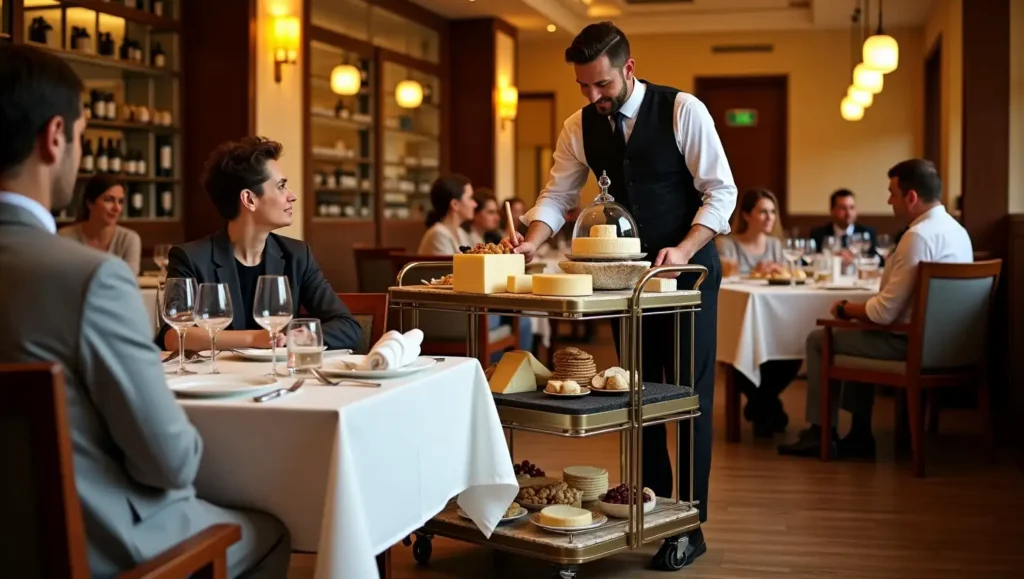
The cheese trolley service is one of the most elegant forms of Gueridon service. Unlike flambé or carving, it doesn’t involve cooking—but instead focuses on presentation, product knowledge, and personalised guest interaction.
In the French classical menu, the cheese course—known as le plateau de fromages—is served after the main course and before dessert. It acts as a flavorful palate cleanser while offering a chance to savour fine wine alongside curated artisanal cheeses.
This tableside service is both educational and indulgent, celebrating the craftsmanship of cheesemakers and affineurs (cheese agers).
The Cheese Trolley:
The cheese trolley is essentially a mobile fromagerie (cheese shop) brought directly to the guest’s table. Its design varies depending on the setting, but always supports both function and finesse.
Key Features of a Cheese Trolley:
- Structure: May range from a simple cart to a polished, multi-tiered display with marble or slate surfaces to help keep cheese cool.
- Protective Cover: Glass or acrylic domes (cloches) protect cheeses from air exposure while allowing guests to view the selection.
- Temperature Control: Some trolleys include light refrigeration for delicate cheeses, though room temperature is ideal for full flavour.
- Specialised Equipment: Includes dedicated cheese knives (for hard, soft, and blue cheeses), service plates, and garnish containers.
The Art of Service: Presentation, Pairing, and Storytelling
Cheese trolley service is a guest-driven experience guided by the knowledge and passion of the server—often referred to as a fromager or “fromellier”,—who explains the types of cheese being offered, their origins, and tasting notes.
How the Service Works:
- Introduction & Presentation: The trolley is wheeled to the guest’s table, showcasing the full cheese selection.
- Storytelling & Education: The server introduces each cheese, sharing its origin, type of milk (cow, goat, or sheep), ageing process, and flavour notes. This transforms the cheese into a cultural and sensory experience.
- Guest Selection: Based on preferences, the guest chooses 3–5 cheeses for a personalised tasting.
- Expert Cutting & Plating: Each cheese is cut correctly depending on its shape (wedge, round, log, or block), then plated in flavour order—typically mild to strong in a clockwise arrangement.
- Accompaniments: Cheeses are paired with items that enhance flavour:
- Breads & crackers
- Fresh fruits (grapes, pears)
- Dried fruits (figs, apricots)
- Nuts, honey, jams, or chutneys
Skills Required
Cheese service may seem simple, but it demands a high level of product knowledge and interpersonal skills.
Key Skills for Cheese Trolley Service:
- Cheese Expertise: Know the origin, milk type, flavour profile, and story behind each cheese.
- Understanding of Affinage: Proper storage, ageing, and tempering to serve cheese at the right texture and flavour.
- Correct Cutting Techniques: Ensure every portion includes both the interior and rind for full expression of flavour.
- Guiding the Guest: Help guests explore new varieties and build a balanced tasting plate.
6. The Dessert Trolley
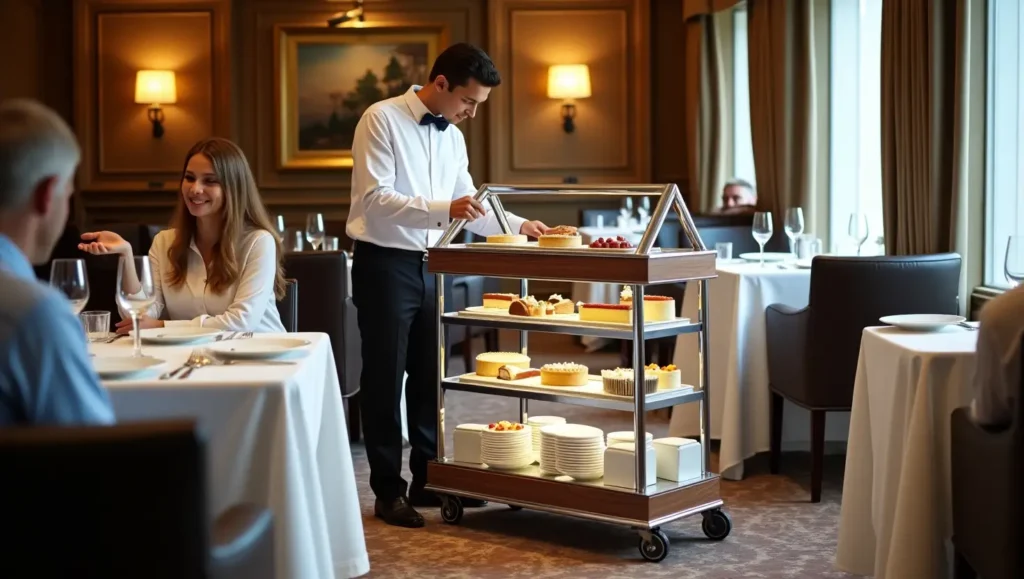
The dessert trolley—also known as the sweet trolley—rose to fame in the mid-20th century, evolving from the tradition of sequential service (service à la russe). It quickly became a tool not just for service, but for upselling and entertainment.
Why It Works:
- Visual Impact: Guests are more likely to order when they see desserts beautifully displayed.
- Nostalgia & Instagram Appeal: The trolley’s comeback in modern dining is fueled by social media and a desire for vintage elegance.
Modern Variations: Modern variations of classic trolleys, which are traditionally made of polished wood or chrome, have evolved in many restaurants to feature custom-designed models. For example, the “Apollo” trolley at Dovetale London is specially built to assemble sundaes tableside, offering a theatrical dessert experience. Other modern designs include multi-tiered carts equipped with cooling sections to keep mousses and other chilled items at the perfect serving temperature.
Signature Tableside Dessert Experiences
Some restaurants go beyond simply serving dessert—they turn it into a theatrical performance. Here are a few iconic and modern examples:
Flambé Classics: Dishes like Crêpes Suzette and Bananas Foster are prepared live with a dramatic flame display, adding both flavour and theatrical flair to the dining experience.
Zabaglione (Sabayon): This warm Italian custard is made by whisking egg yolks, sugar, and Marsala wine over a hot water bath (bain-marie) until it becomes frothy and rich. It is typically served immediately with fresh fruits or cake.
Curated Dessert Displays:
The trolley is wheeled to the table, where the server presents an array of dessert options such as layered cakes, tarts, cheesecakes, fruit salads, and mousses. Guests make their selections, and the chosen desserts are plated with flair, adding a touch of elegance and theatre to the dining experience.
Examples:
- Ballymaloe House, Ireland – Known for its seasonal, changing dessert trolleys
- M. Wells Steakhouse, NYC – Famous for a playful, creative selection
Theatrical, Modern Twists:
At Cesarina in San Diego, a deconstructed tiramisu is artfully assembled in front of the guest, offering a personalised and interactive dessert experience. Meanwhile, at Dinner by Heston in London, liquid nitrogen is used to freeze ice cream tableside, producing dramatic clouds of vapour that enhance the sense of culinary theatre.
7. Liquid Artistry: Beverage-Based Gueridon Service

Gueridon service is not limited to food; it extends to the preparation and presentation of beverages, transforming the simple act of ordering a drink into a sophisticated and personalised ritual.
This form of service, often performed from a liqueur or cocktail trolley, includes various types of beverages such as after-dinner coffees, digestifs, and classic cocktails, adding a final touch of theatre to the dining experience and turning each drink into a memorable event.
The Liqueur & Cocktail Trolley: A Bar on Wheels
The beverage trolley is a compact, mobile bar, elegantly designed and stocked to create a range of drinks tableside. Its typical features include :
- Multi-tiered Shelves: To hold an array of bottles, including various spirits (whiskey, gin, vodka, rum), liqueurs (Cointreau, amaretto), vermouths, and bitters.
- Glassware Storage: Racks or fitted sections to securely hold different types of glassware, such as snifters, martini glasses, and specialised coffee glasses.
- Bar Tools: A full complement of professional bar tools is essential, including a cocktail shaker, mixing glass, jigger for measuring, bar spoon, strainer, and bottle openers.
- Garnishes and Ice: A section for fresh garnishes like citrus peels, olives, and cherries, as well as a stylish ice bucket and tongs.
Classic and Contemporary Examples
Tableside beverage service encompasses both time-honoured traditions and modern trends.
- Irish Coffee: This is the quintessential tableside beverage preparation. The service is a demonstration of precise technique and history, tracing its origins to Joe Sheridan at Foynes Port in the 1940s. The classic preparation involves:
- Warm a heatproof glass with hot water.
- Dissolve brown sugar in strong, hot coffee directly in the glass.
- Adding a generous measure of Irish whiskey and stirring.
- The final, crucial step is floating a layer of thick, lightly whipped cream on top, traditionally by pouring it slowly over the back of a warm spoon to create a distinct separation. The coffee is meant to be drunk hot through the cool layer of cream.
- Martini Trolley: A symbol of ultimate cocktail sophistication, the martini trolley brings the art of the bar to the guest. Famously perfected at establishments like The Connaught Bar in London, a bartender prepares a bespoke martini at the table. This involves a conversation with the guest about their preferences: gin or vodka, the desired level of vermouth (“dryness”), and the choice of garnish (a twist of lemon or an olive). The cocktail is then stirred or shaken and served with theatrical flair.
- Modern Smoked Cocktails: A contemporary trend that leverages the visual appeal of Gueridon service. A cocktail, typically a spirit-forward classic like an Old Fashioned or Manhattan, is prepared and then placed under a glass cloche. Using a handheld smoking gun, aromatic smoke (from wood chips like applewood or hickory) is piped into the cloche, infusing the drink. The cloche is then brought to the table, and the reveal of the smoke-filled glass creates a dramatic sensory experience for the guest.
- Speciality Coffees and Digestifs: The trolley can also be used to serve a range of after-dinner drinks, such as Spanish Coffee (which is flambéed) or to present a curated selection of digestifs like Cognac, Armagnac, or amaro.
Required Skills: Tableside Mixology and Spirits Knowledge
The server for this service must be a skilled bartender with excellent front-of-house presence.
- Mixology Expertise: A comprehensive knowledge of classic cocktail recipes, proportions, and techniques is required. They must be able to craft a balanced drink flawlessly in a non-bar environment.
- Deep Spirit Knowledge: The ability to discuss the nuances of different spirits—the botanicals in a gin, the mash bill of a bourbon, the age of a cognac—is essential for guiding the guest and elevating the experience.
- Grace and Precision: The server must be able to measure, pour, and mix drinks with a steady hand, avoiding spills and maintaining an air of elegance and control in the confined space around a dining table.
Conclusion
Gueridon service brings a unique sense of theatre and tradition to the dining room. From dramatic flambé dishes to elegant cheese or dessert trolleys, each style showcases skill, hospitality, and guest interaction.
Though it declined in popularity during the late 20th century, Gueridon service is making a strong comeback. Today’s guests crave memorable experiences and visually striking moments—often shared on social media. This tableside service turns a meal into a performance.
In a fast-paced, tech-driven world, Gueridon service stands out by celebrating personalised attention and craftsmanship. It’s not just about food—it’s about creating lasting memories, one table at a time.
Related Articles:
- Wine Service Procedure in Restaurants: A Detailed Step-by-Step Guide
- What Are the Different Types of Cooking Methods? Explained with Examples
- Types of Food and Beverage Service: A Complete Guide for the Hospitality
- Sequence of Service in Restaurants: Steps of Table Service in Fine Dining
- Room Service in Hotels Explained: A Complete Guide
This article was written by Saswata Banerjee, the creator of Food and Beverage Service Knowledge, based on 8+ years of experience in the hospitality industry.

